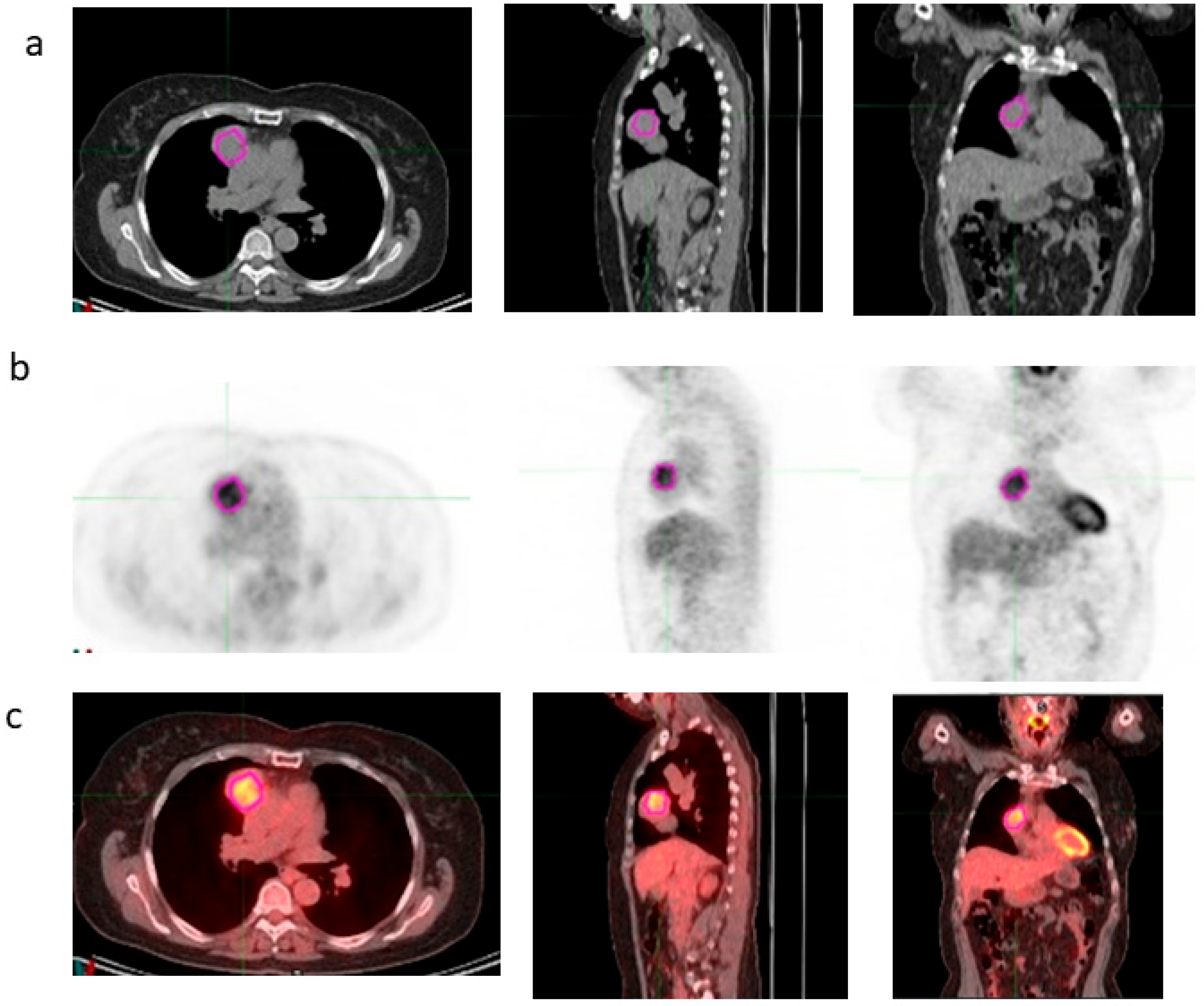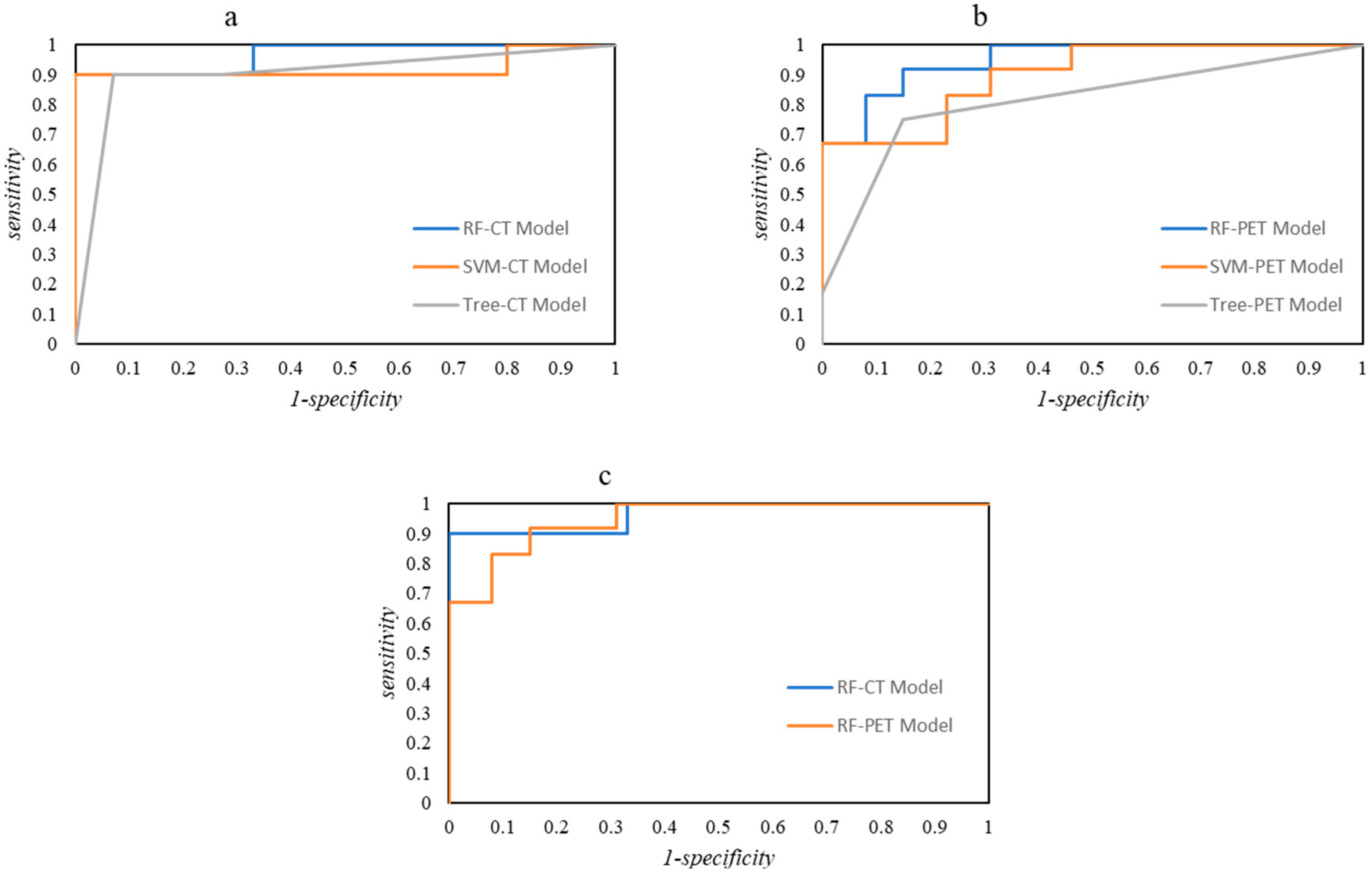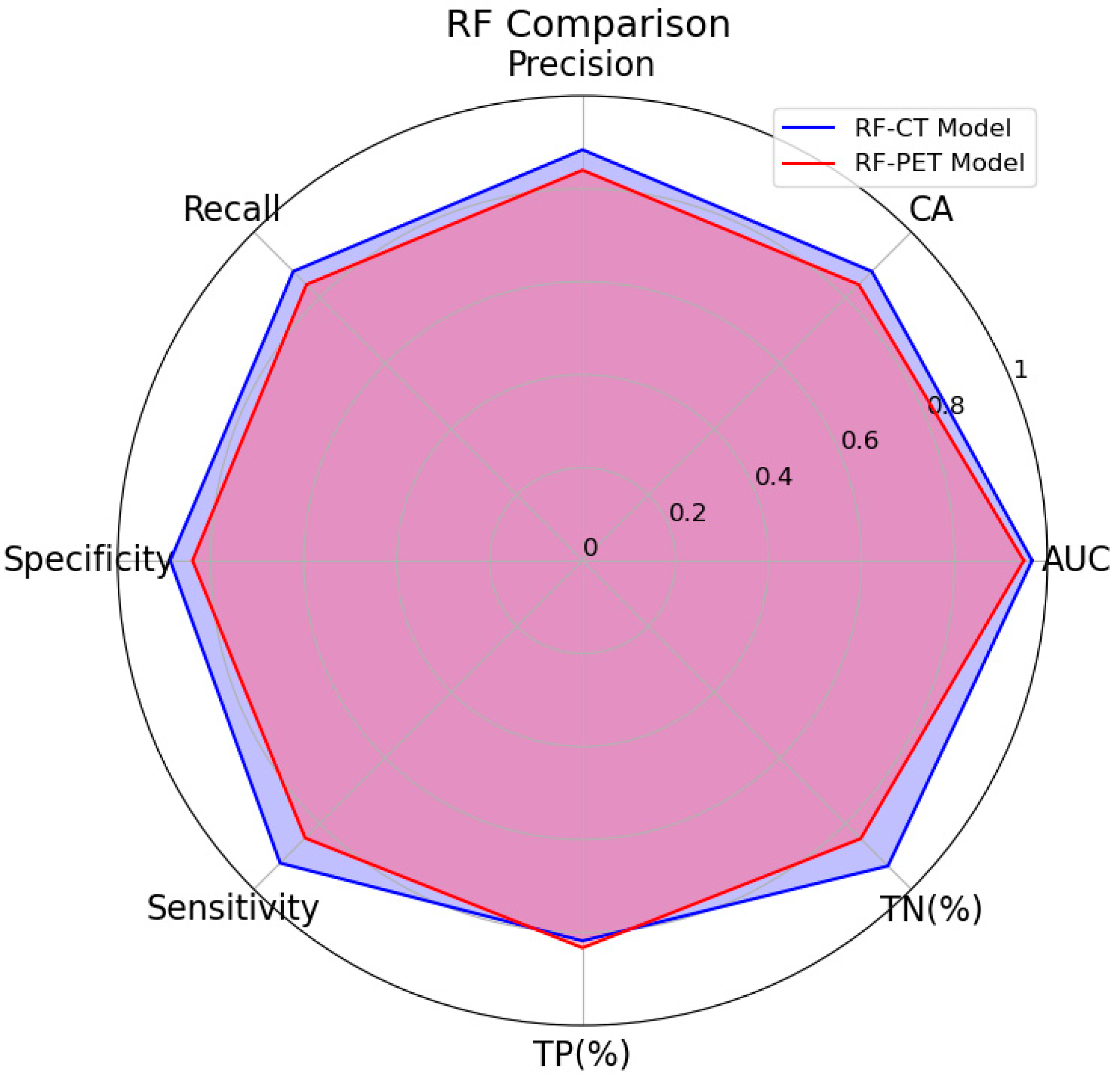Machine Learning Models Derived from [18F]FDG PET/CT for the Prediction of Recurrence in Patients with Thymomas
Abstract
1. Introduction
2. Materials and Methods
2.1. Study Population
2.2. Follow-Up
2.3. [18F]FDG PET/CT Imaging
2.4. Imaging Post-Processing and Features Extraction
2.5. Statistical Analysis and Model Building
3. Results
3.1. Patients’ Characteristics
3.2. [18F]FDG PET/CT Analysis
3.3. Radiomic Analysis and Model Building
4. Discussion
5. Conclusions
Supplementary Materials
Author Contributions
Funding
Institutional Review Board Statement
Informed Consent Statement
Data Availability Statement
Acknowledgments
Conflicts of Interest
References
- Girard, N.; Ruffini, E.; Marx, A.; Faivre-Finn, C.; Peters, S.; ESMO Guidelines Committee. Thymic epithelial tumours: ESMO Clinical Practice Guidelines for diagnosis, treatment and follow-up. Ann. Oncol. 2015, 26 (Suppl. 5), v40–v55. [Google Scholar] [CrossRef]
- Marx, A.; Ströbel, P.; Badve, S.S.; Chalabreysse, L.; Chan, J.K.; Chen, G.; de Leval, L.; Detterbeck, F.; Girard, N.; Huang, J.; et al. ITMIG consensus statement on the use of the WHO histological classification of thymoma and thymic carcinoma: Refined definitions, histological criteria, and reporting. J. Thorac. Oncol. 2014, 9, 596–611. [Google Scholar] [CrossRef]
- Okumura, M.; Ohta, M.; Tateyama, H.; Nakagawa, K.; Matsumura, A.; Maeda, H.; Tada, H.; Eimoto, T.; Matsuda, H.; Masaoka, A. The World Health Organization histologic classification system reflects the oncologic behavior of thymoma: A clinical study of 273 patients. Cancer 2002, 94, 624–632. [Google Scholar] [CrossRef] [PubMed]
- Kondo, K.; Yoshizawa, K.; Tsuyuguchi, M.; Kimura, S.; Sumitomo, M.; Morita, J.; Miyoshi, T.; Sakiyama, S.; Mukai, K.; Monden, Y. WHO histologic classification is a prognostic indicator in thymoma. Ann. Thorac. Surg. 2004, 77, 1183–1188. [Google Scholar] [CrossRef] [PubMed]
- Altshuler, E.; Mathavan, A.; Krekora, U.; Mathavan, M.; Hones, K.; Daily, K. Clinical characteristics, prognostic factors, and long-term outcomes associated with epithelial malignancies of the thymus: A 20-year single-institution experience. Cancer Rep. 2022, 6, e1750. [Google Scholar] [CrossRef]
- Falkson, C.B.; Vella, E.T.; Ellis, P.M.; Maziak, D.E.; Ung, Y.C.; Yu, E. Surgical, radiation, and systemic treatments of patients with thymic epithelial tumours: A Clinical Practice Guideline. J. Thorac. Oncol. 2022, 17, 1258–1275. [Google Scholar] [CrossRef]
- Viti, A.; Bertolaccini, L.; Cavallo, A.; Fortunato, M.; Bianchi, A.; Terzi, A. 18-Fluorine fluorodeoxyglucose positron emission tomography in the pretreatment evaluation of thymic epithelial neoplasms: A ‘metabolic biopsy’ confirmed by Ki-67 expression. Eur. J. Cardio-Thorac. Surg. 2014, 46, 369–374. [Google Scholar] [CrossRef] [PubMed]
- Matsumoto, I.; Oda, M.; Takizawa, M.; Waseda, R.; Nakajima, K.; Kawano, M.; Mochizuki, T.; Ikeda, H.; Watanabe, G. Usefulness of fluorine-18 fluorodeoxyglucose–positron emission tomography in management strategy for thymic epithelial tumors. Ann. Thorac. Surg. 2013, 95, 305–310. [Google Scholar] [CrossRef] [PubMed]
- Treglia, G.; Sadeghi, R.; Giovanella, L.; Cafarotti, S.; Filosso, P.; Lococo, F. Is 18F-FDG PET useful in predicting the WHO grade of malignancy in thymic epithelial tumors? A meta-analysis. Lung Cancer 2014, 86, 5–13. [Google Scholar] [CrossRef]
- Chiappetta, M.; Mendogni, P.; Cattaneo, M.; Evangelista, J.; Farina, P.; Pizzuto, D.A.; Annunziata, S.; Castello, A.; Congedo, M.T.; Tabacco, D.; et al. Is PET/CT Able to Predict Histology in Thymic Epithelial Tumours? A Narrative Review. Diagnostics 2022, 13, 98. [Google Scholar] [CrossRef]
- Civan, C.; Ozkan, Z.G.; Ozkan, B.; Isik, E.G.; Erdogdu, E.; Simsek, D.H.; Duman, S.; Sanli, Y.; Kara, M.; Kuyumcu, S.; et al. The Role of [18F]FDG PET/CT in the Characterization of Thymic Epithelial Tumors at Initial Stage. Cancer Biother. Radiopharm. 2024, 39, 373–380. [Google Scholar] [CrossRef]
- Benveniste, M.F.; Moran, C.A.; Mawlawi, O.; Fox, P.S.; Swisher, S.G.; Munden, R.F.; Marom, E.M. FDG PET-CT aids in the preoperative assessment of patients with newly diagnosed thymic epithelial malignancies. J. Thorac. Oncol. 2013, 8, 502–510. [Google Scholar] [CrossRef]
- Park, S.Y.; Cho, A.; Bae, M.K.; Lee, C.Y.; Kim, D.J.; Chung, K.Y. Value of 18F-FDG PET/CT for predicting the world health organization malignant grade of thymic epithelial tumors. Clin. Nucl. Med. 2016, 41, 15–20. [Google Scholar] [CrossRef]
- Seki, N.; Sakamoto, S.; Karube, Y.; Oyaizu, T.; Ishihama, H.; Chida, M. 18F-fluorodeoxyglucose positron emission tomography for evaluation of thymic epithelial tumors: Utility for World Health Organization classification and predicting recurrence-free survival. Ann. Nucl. Med. 2014, 28, 257–262. [Google Scholar] [CrossRef]
- Lee, J.; Cho, Y.S.; Kim, J.; Shim, Y.M.; Lee, K.-H.; Choi, J.Y. Prognostic significance of metabolic parameters by 18F-FDG PET/CT in thymic epithelial tumors. Cancers 2021, 13, 712. [Google Scholar] [CrossRef] [PubMed]
- Huang, J.; Detterbeck, F.C.; Wang, Z.; Loehrer, P.J. Standard outcome measures for thymic malignancies. J. Thorac. Oncol. 2010, 5, 2017–2023. [Google Scholar] [CrossRef] [PubMed]
- Gillies, R.J.; Kinahan, P.E.; Hricak, H. Radiomics: Images are more than pictures, they are data. Radiology 2016, 278, 563–577. [Google Scholar] [CrossRef] [PubMed]
- Erickson, B.J.; Korfiatis, P.; Akkus, Z.; Kline, T.L. Machine learning for medical imaging. Radiographics 2017, 37, 505–515. [Google Scholar] [CrossRef]
- Filippi, L.; Urso, L.; Bianconi, F.; Palumbo, B.; Marzola, M.C.; Evangelista, L.; Schillaci, O. Radiomics and theranostics with molecular and metabolic probes in prostate cancer: Toward a personalized approach. Expert Rev. Mol. Diagn. 2023, 23, 243–255. [Google Scholar] [CrossRef]
- Lee, H.S.; Oh, J.S.; Park, Y.S.; Jang, S.J.; Choi, I.S.; Ryu, J.-S. Differentiating the grades of thymic epithelial tumor malignancy using textural features of intratumoral heterogeneity via 18F-FDG PET/CT. Ann. Nucl. Med. 2016, 30, 309–319. [Google Scholar] [CrossRef]
- Nakajo, M.; Jinguji, M.; Shinaji, T.; Nakajo, M.; Aoki, M.; Tani, A.; Sato, M.; Yoshiura, T. Texture analysis of 18F-FDG PET/CT for grading thymic epithelial tumours: Usefulness of combining SUV and texture parameters. Br. J. Radiol. 2018, 91, 20170546. [Google Scholar] [CrossRef]
- Gao, C.; Yang, L.; Xu, Y.; Wang, T.; Ding, H.; Gao, X.; Li, L. Differentiating low-risk thymomas from high-risk thymomas: Preoperative radiomics nomogram based on contrast enhanced CT to minimize unnecessary invasive thoracotomy. BMC Med. Imaging 2024, 24, 197. [Google Scholar] [CrossRef] [PubMed]
- Pizzuto, D.A.; Castello, A.; Chiappetta, M.; Castellani, M.; Annunziata, S.; Campanella, A.; Calabrese, G.; Cattaneo, M.; Rosso, L.; Cusumano, G.; et al. The Role of [18F]F-FDG PET/CT for Predicting Histology and Prognosis in Patients with Thymic Lesions. Mol. Diagn. Ther. 2025, 29, 239–248. [Google Scholar] [CrossRef] [PubMed]
- Fedorov, A.; Beichel, R.; Kalpathy-Cramer, J.; Finet, J.; Fillion-Robin, J.C.; Pujol, S.; Bauer, C.; Jennings, D.; Fennessy, F.; Sonka, M.; et al. 3D Slicer as an Image Computing Platform for the Quantitative Imaging Network. Magn. Reson. Imaging 2012, 30, 1323–1341. [Google Scholar] [CrossRef] [PubMed]
- Urso, L.; Cittanti, C.; Manco, L.; Ortolan, N.; Borgia, F.; Malorgio, A.; Scribano, G.; Mastella, E.; Guidoboni, M.; Stefanelli, A.; et al. ML Models Built Using Clinical Parameters and Radiomic Features Extracted from 18F-Choline PET/CT for the Prediction of Biochemical Recurrence after Metastasis-Directed Therapy in Patients with Oligometastatic Prostate Cancer. Diagnostics 2024, 14, 1264. [Google Scholar] [CrossRef]
- Lococo, F.; De Paolis, E.; Evangelista, J.; Dell’amore, A.; Giannarelli, D.; Chiappetta, M.; Campanella, A.; Sassorossi, C.; Cancellieri, A.; Calabrese, F.; et al. Comparative Analysis of Comprehensive Genomic Profile in Thymomas and Recurrent Thymomas Reveals Potentially Actionable Mutations for Target Therapies. Int. J. Mol. Sci. 2024, 25, 9560. [Google Scholar] [CrossRef]
- Caloro, E.; Gnocchi, G.; Quarrella, C.; Ce, M.; Carrafiello, G.; Cellina, M. Artificial Intelligence in Bone Metastasis Imaging: Recent Progresses from Diagnosis to Treatment—A Narrative Review. Crit. Rev. Oncog. 2024, 29, 77–90. [Google Scholar] [CrossRef]
- Cè, M.; Cellina, M.; Ueanukul, T.; Carrafiello, G.; Manatrakul, R.; Tangkittithaworn, P.; Jaovisidha, S.; Fuangfa, P.; Resnick, D. Multimodal Imaging of Osteosarcoma: From First Diagnosis to Radiomics. Cancers 2025, 17, 599. [Google Scholar] [CrossRef]
- Ciarmiello, A.; Giovannini, E.; Tutino, F.; Yosifov, N.; Milano, A.; Florimonte, L.; Bonatto, E.; Bareggi, C.; Dellavedova, L.; Castello, A.; et al. Does FDG PET-Based Radiomics Have an Added Value for Prediction of Overall Survival in Non-Small Cell Lung Cancer? J. Clin. Med. 2024, 13, 2613. [Google Scholar] [CrossRef]
- Evangelista, L.; Fiz, F.; Laudicella, R.; Bianconi, F.; Castello, A.; Guglielmo, P.; Liberini, V.; Manco, L.; Frantellizzi, V.; Giordano, A.; et al. PET Radiomics and Response to Immunotherapy in Lung Cancer: A Systematic Review of the Literature. Cancers 2023, 15, 3258. [Google Scholar] [CrossRef]
- Nakajo, M.; Takeda, A.; Katsuki, A.; Jinguji, M.; Ohmura, K.; Tani, A.; Sato, M.; Yoshiura, T. The efficacy of 18F-FDG-PET-based radiomic and deep-learning features using a machine-learning approach to predict the pathological risk subtypes of thymic epithelial tumors. Br. J. Radiol. 2022, 95, 20211050. [Google Scholar] [CrossRef] [PubMed]
- Nieri, A.; Manco, L.; Bauckneht, M.; Urso, L.; Caracciolo, M.; Donegani, M.I.; Borgia, F.; Vega, K.; Colella, A.; Ippolito, C.; et al. [18F]FDG PET-TC radiomics and machine learning in the evaluation of prostate incidental uptake. Expert Rev. Med. Devices 2023, 20, 1183–1191. [Google Scholar] [CrossRef] [PubMed]
- Yuan, H.; Yu, K.; Xie, F.; Liu, M.; Sun, S. Automated machine learning with interpretation: A systematic review of methodologies and applications in healthcare. Med. Adv. 2024, 2, 205–237. [Google Scholar] [CrossRef]
- Urso, L.; Manco, L.; Cittanti, C.; Adamantiadis, S.; Szilagyi, K.E.; Scribano, G.; Mindicini, N.; Carnevale, A.; Bartolomei, M.; Giganti, M. 18F-FDG PET/CT radiomic analysis and artificial intelligence to predict pathological complete response after neoadjuvant chemotherapy in breast cancer patients. Radiol. Medica 2025, 130, 543–554. [Google Scholar] [CrossRef]



| Variables | FFR 0 | FFR 1 | Tot | p |
|---|---|---|---|---|
| 42 (84%) | 8 (16%) | 50 | ||
| Age | 63.95 ± 12.27 | 56.25 ± 11.97 | 62.72 ± 12.43 | |
| Sex | 0.44 | |||
| Male | 20 (48%) | 5 (63%) | 25 (50%) | |
| Female | 22 (52%) | 3 (38%) | 25 (50%) | |
| FFR months | 41.36 ± 32.92 | 24 ± 15.6 | 38.88 ± 31.52 | 0.55 |
| WHO | 0.007 | |||
| LR | 27 (64%) | 1 (13%) | 28 (56%) | |
| HR | 15 (36%) | 7 (88%) | 22 (44%) | |
| Miastenia G | 0.105 | |||
| No | 24 | 7 | 31 | |
| Yes | 18 | 1 | 19 | |
| Masaoka | <0.001 | |||
| I | 5 | 0 | 5 | |
| IIa | 25 | 0 | 25 | |
| IIb | 6 | 2 | 8 | |
| III | 5 | 2 | 7 | |
| IV | 1 | 4 | 5 | |
| 8th TNM stage | <0.001 | |||
| I | 36 | 2 | 38 | |
| III | 5 | 2 | 7 | |
| IV | 1 | 4 | 5 |
| FFR 0 | FFR 1 | Tot | p 1 | |
|---|---|---|---|---|
| 42 | 8 | 50 | ||
| SUVmax | 4.95 ± 1.94 | 8.39 ± 5.1 | 5.5 ± 2.91 | >0.05 |
| SUVmean | 2.96 ± 1.02 | 4.92 ± 3.22 | 3.27 ± 1.7 | >0.05 |
| SUVpeak | 4.14 ± 1.67 | 7.01 ± 3.97 | 4.6 ± 2.39 | >0.05 |
| TLG | 207.36 ± 401.63 | 1829.02 ± 2986.12 | 466.83 ± 1330.22 | >0.05 |
| MTV | 55.72 ± 84.13 | 376.36 ± 533.48 | 107.02 ± 246.33 | >0.05 |
| T_cm | 4.92 ± 2.61 | 10.85 ± 7.89 | 5.87 ± 4.41 | >0.05 |
| rPET (T/L) | 1.74 ± 0.72 | 3.62 ± 2.44 | 2.04 ± 1.33 | <0.001 |
| qPET (N/U) | 1.79 ± 0.75 | 3.68 ± 2.11 | 2.09 ± 1.26 | <0.001 |
| SUVmax_T/Tcm | 1.15 ± 0.53 | 1.74 ± 2.81 | 1.25 ± 1.18 | >0.05 |
| T/M | 2.75 ± 1.12 | 5.86 ± 4.59 | 3.25 ± 2.32 | <0.001 |
| AUC | CA | PREC | REC | SPEC | |
|---|---|---|---|---|---|
| CT Model | |||||
| RF | 0.96 | 0.90 | 0.90 | 0.90 | 0.90 |
| SVM | 0.88 | 0.83 | 0.84 | 0.83 | 0.84 |
| Tree | 0.86 | 0.85 | 0.85 | 0.85 | 0.85 |
| PET Model | |||||
| RF | 0.99 | 0.95 | 0.95 | 0.95 | 0.95 |
| SVM | 0.98 | 0.88 | 0.88 | 0.88 | 0.88 |
| Tree | 0.90 | 0.92 | 0.92 | 0.92 | 0.92 |
| AUC | CA | PREC | REC | SPEC | SEN | TP (%) | TN (%) | |
|---|---|---|---|---|---|---|---|---|
| CT Model | ||||||||
| RF | 0.97 | 0.88 | 0.88 | 0.88 | 0.89 | 0.92 | 81.8 | 92.9 |
| SVM | 0.92 | 0.84 | 0.85 | 0.84 | 0.86 | 0.91 | 75.1 | 92.3 |
| Tree | 0.91 | 0.80 | 0.83 | 0.80 | 0.83 | 0.89 | 69.2 | 91.7 |
| PET Model | ||||||||
| RF | 0.95 | 0.84 | 0.84 | 0.85 | 0.84 | 0.84 | 83.3 | 84.6 |
| SVM | 0.90 | 0.77 | 0.76 | 0.76 | 0.76 | 0.77 | 75.0 | 76.9 |
| Tree | 0.81 | 0.80 | 0.80 | 0.80 | 0.80 | 0.79 | 81.8 | 78.6 |
Disclaimer/Publisher’s Note: The statements, opinions and data contained in all publications are solely those of the individual author(s) and contributor(s) and not of MDPI and/or the editor(s). MDPI and/or the editor(s) disclaim responsibility for any injury to people or property resulting from any ideas, methods, instructions or products referred to in the content. |
© 2025 by the authors. Licensee MDPI, Basel, Switzerland. This article is an open access article distributed under the terms and conditions of the Creative Commons Attribution (CC BY) license (https://creativecommons.org/licenses/by/4.0/).
Share and Cite
Castello, A.; Manco, L.; Cattaneo, M.; Orlandi, R.; Rosso, L.; Croci, G.A.; Florimonte, L.; Scribano, G.; Turra, A.; Ferrero, S.; et al. Machine Learning Models Derived from [18F]FDG PET/CT for the Prediction of Recurrence in Patients with Thymomas. Bioengineering 2025, 12, 721. https://doi.org/10.3390/bioengineering12070721
Castello A, Manco L, Cattaneo M, Orlandi R, Rosso L, Croci GA, Florimonte L, Scribano G, Turra A, Ferrero S, et al. Machine Learning Models Derived from [18F]FDG PET/CT for the Prediction of Recurrence in Patients with Thymomas. Bioengineering. 2025; 12(7):721. https://doi.org/10.3390/bioengineering12070721
Chicago/Turabian StyleCastello, Angelo, Luigi Manco, Margherita Cattaneo, Riccardo Orlandi, Lorenzo Rosso, Giorgio Alberto Croci, Luigia Florimonte, Giovanni Scribano, Alessandro Turra, Stefano Ferrero, and et al. 2025. "Machine Learning Models Derived from [18F]FDG PET/CT for the Prediction of Recurrence in Patients with Thymomas" Bioengineering 12, no. 7: 721. https://doi.org/10.3390/bioengineering12070721
APA StyleCastello, A., Manco, L., Cattaneo, M., Orlandi, R., Rosso, L., Croci, G. A., Florimonte, L., Scribano, G., Turra, A., Ferrero, S., Nosotti, M., Carrafiello, G., Castellani, M., & Mendogni, P. (2025). Machine Learning Models Derived from [18F]FDG PET/CT for the Prediction of Recurrence in Patients with Thymomas. Bioengineering, 12(7), 721. https://doi.org/10.3390/bioengineering12070721








